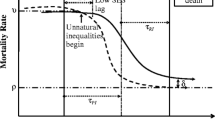Abstract
In the theory of syndemics, diseases are hypothesized to co-occur in particular temporal or geographical contexts due to harmful social conditions (disease concentration) and to interact at the level of populations and individuals, with mutually enhancing deleterious consequences for HIV risk (disease interaction). Since its original elaboration more than 20 years ago, the epidemiological literature on syndemic problems has followed a questionable trajectory, stemming from the use of a specific type of regression model specification that conveys very little information about the theory of syndemics. In this essay we critically review the dominant approaches to modeling in the literature on syndemics; highlight the stringent assumptions implicit in these models; and describe some meaningful public health implications of the resulting analytical ambiguities. We conclude with specific recommendations for empirical work in this area moving forward.
Similar content being viewed by others
References
Singer M. AIDS and the health crisis of the U.S. urban poor; the perspective of critical medical anthropology. Soc Sci Med. 1994;39(7):931–48.
Singer M. A dose of drugs, a touch of violence, a case of AIDS: conceptualizing the SAVA syndemic. Free Inq Creat Sociol. 1996;24(2):99–110.
Singer M. A dose of drugs, a touch of violence, a case of AIDS, part 2: further conceptualizing the SAVA syndemic. Free Inq Creat Sociol. 2006;34(1):39–53.
Link BG, Phelan J. Social conditions as fundamental causes of disease. J. Health Soc. Behav. 1995;35(Extra Issue):80–94.
Farmer P, Lindenbaum S, Good MJ. Women, poverty and AIDS: an introduction. Cult Med Psychiatry. 1993;17(4):387–97.
Farmer P. Women, poverty, and AIDS. In: Farmer P, Connors M, Simmons J, editors. Women, poverty and AIDS: sex, drugs, and structural violence. Monroe: Common Courage Press; 1996. p. 3–38.
van den Akker M, Buntinx F, Knottnerus JA. Comorbidity or multimorbidity; what’s in a name? A review of literature. Eur J Gen Pract. 1996;2(2):65–70.
van den Akker M, Buntinx F, Metsemakers JF, Roos S, Knottnerus JA. Multimorbidity in general practice: prevalence, incidence, and determinants of co-occurring chronic and recurrent diseases. J Clin Epidemiol. 1998;51(5):367–75.
Lehman AF, Myers CP, Corty E. Assessment and classification of patients with psychiatric and substance abuse syndromes. Hosp Community Psychiatry. 1989;40(10):1019–25.
Drake RE, McLaughlin P, Pepper B, Minkoff K. Dual diagnosis of major mental illness and substance disorder: an overview. New Dir Ment Health Serv. 1991;50:3–12.
Tsai AC, Burns BFO. Syndemics of psychosocial problems and HIV risk: a systematic review of empirical tests of the disease interaction concept. Soc Sci Med. 2015;139(1):26–35.
Operario D, Nemoto T. HIV in transgender communities: syndemic dynamics and a need for multicomponent interventions. J Acquir Immune Defic Syndr. 2010;55(Suppl 2):S91–3.
Illangasekare S, Burke J, Chander G, Gielen A. The syndemic effects of intimate partner violence, HIV/AIDS, and substance abuse on depression among low-income urban women. J Urban Health. 2013;90(5):934–47.
Coughlin SS. Invited commentary: co-occurring health conditions among women living with profound life challenges. Am J Epidemiol. 2011;174(5):523–5 Discussion 526–527.
Tsai AC, Weiser SD, Dilworth SE, Shumway M, Riley ED. Violent victimization, mental health, and service utilization outcomes in a cohort of homeless and unstably housed women living with or at risk of becoming infected with HIV. Am J Epidemiol. 2015;181(10):817–26.
Batchelder AB. Psychosocial syndemics of women living with and at-risk for HIV/AIDS (dissertation). New York: Yeshiva University; 2012.
Pitpitan EV, Kalichman SC, Eaton LA, et al. Co-occurring psychosocial problems and HIV risk among women attending drinking venues in a South African township: a syndemic approach. Ann Behav Med. 2013;45(2):153–62.
Wooldridge JM. Econometric analysis of cross section and panel data. Cambridge: MIT Press; 2002.
Angrist JD, Pischke J-S. Mostly harmless econometrics: an empiricist’s companion. Princeton: Princeton University Press; 2009.
Huber PJ. The behavior of maximum likelihood estimates under nonstandard conditions. Proceedings of the fifth Berkeley Symposium on Mathematical Statistics and Probability, vol. 1. Berkeley: University of California Press; 1967:221–33.
White H. A heteroskedasticity-consistent covariance matrix estimator and a direct test for heteroskedasticity. Econometrica. 1980;48(4):817–30.
Weiser SD, Leiter K, Bangsberg DR, et al. Food insufficiency is associated with high-risk sexual behavior among women in Botswana and Swaziland. PLoS Med. 2007;4(10):1589–97 discussion 1598.
Tsai AC, Subramanian SV. Proximate context of gender-unequal norms and women’s HIV risk in sub-Saharan Africa. AIDS. 2012;26(3):381–6.
Jewkes RK, Dunkle K, Nduna M, Shai N. Intimate partner violence, relationship power inequity, and incidence of HIV infection in young women in South Africa: a cohort study. Lancet. 2010;376(9734):41–8.
Charlson ME, Pompei P, Ales KL, MacKenzie CR. A new method of classifying prognostic comorbidity in longitudinal studies: development and validation. J Chronic Dis. 1987;40(5):373–83.
Elixhauser A, Steiner C, Harris DR, Coffey RM. Comorbidity measures for use with administrative data. Med Care. 1998;36(1):8–27.
Mustanski B, Garofalo R, Herrick A, Donenberg G. Psychosocial health problems increase risk for HIV among urban young men who have sex with men: preliminary evidence of a syndemic in need of attention. Ann Behav Med. 2007;34(1):37–45.
Biello KB, Colby D, Closson E, Mimiaga MJ. The syndemic condition of psychosocial problems and HIV risk among male sex workers in Ho Chi Minh City, Vietnam. AIDS Behav. 2014;18(7):1264–71.
Mimiaga MJ, O’Cleirigh C, Biello KB, et al. The effect of psychosocial syndemic production on 4-year HIV incidence and risk behavior in a large cohort of sexually active men who have sex with men. J Acquir Immune Defic Syndr. 2015;68(3):329–36.
Stall R, Mills TC, Williamson J, et al. Association of co-occurring psychosocial health problems and increased vulnerability to HIV/AIDS among urban men who have sex with men. Am J Public Health. 2003;93(6):939–42.
Anda RF, Croft JB, Felitti VJ, et al. Adverse childhood experiences and smoking during adolescence and adulthood. JAMA. 1999;282(17):1652–8.
Sameroff AJ, Seifer R, Barocas R, Zax M, Greenspan S. Intelligence quotient scores of 4-year-old children: social-environmental risk factors. Pediatrics. 1987;79(3):343–50.
Turner RJ, Lloyd DA. Lifetime traumas and mental health: the significance of cumulative adversity. J Health Soc Behav. 1995;36(4):360–76.
Felitti VJ, Anda RF, Nordenberg D, et al. Relationship of childhood abuse and household dysfunction to many of the leading causes of death in adults. The Adverse Childhood Experiences (ACE) Study. Am J Prev Med. 1998;14(4):245–58.
Green JG, McLaughlin KA, Berglund PA, et al. Childhood adversities and adult psychiatric disorders in the national comorbidity survey replication I: associations with first onset of DSM-IV disorders. Arch Gen Psychiatry. 2010;67(2):113–23.
Montez JK, Hayward MD. Cumulative childhood adversity, educational attainment, and active life expectancy among U.S. adults. Demography. 2014;51(2):413–35.
Rutter M, Quinton D. Psychiatric disorder: ecological factors and concepts of causation. In: McGurk H, editor. Ecological factors in human development. Amsterdam: North-Holland Publishing Co.; 1977. p. 173–87.
Luthar SS. Annotation: methodological and conceptual issues in research on childhood resilience. J Child Psychol Psychiatry. 1993;34(4):441–53.
Singer M, Clair S. Syndemics and public health: reconceptualizing disease in bio-social context. Med Anthropol Q. 2003;17(4):423–41.
Riley ED, Cohen J, Knight KR, Decker A, Marson K, Shumway M. Recent violence in a community-based sample of homeless and unstably housed women with high levels of psychiatric comorbidity. Am J Pub Health. 2014;104(9):1657–63.
Riley ED, Moore K, Sorensen JL, Tulsky JP, Bangsberg DR, Neilands TB. Basic subsistence needs and overall health among human immunodeficiency virus-infected homeless and unstably housed women. Am J Epidemiol. 2011;174(5):515–22.
West SG, Aiken LS, Todd M. Probing the effects of individual components in multiple component prevention programs. Am J Community Psychol. 1993;21(5):571–605.
King TK, Marcus BH, Pinto BM, Emmons KM, Abrams DB. Cognitive-behavioral mediators of changing multiple behaviors: smoking and a sedentary lifestyle. Prev Med. 1996;25(6):684–91.
Spring B, Pagoto S, Pingitore R, Doran N, Schneider K, Hedeker D. Randomized controlled trial for behavioral smoking and weight control treatment: effect of concurrent versus sequential intervention. J Consult Clin Psychol. 2004;72(5):785–96.
Tsai AC, Weiser SD, Petersen ML, Ragland K, Kushel MB, Bangsberg DR. A marginal structural model to estimate the causal effect of antidepressant medication treatment on viral suppression among homeless and marginally housed persons with HIV. Arch Gen Psychiatry. 2010;67(12):1282–90.
Katz IT, Tsai AC. Psychological therapy to improve HIV care and reduce stigma. Lancet HIV. 2015;2(5):e172–3.
Collins LM, Murphy SA, Nair VN, Strecher VJ. A strategy for optimizing and evaluating behavioral interventions. Ann Behav Med. 2005;30(1):65–73.
Nair V, Strecher V, Fagerlin A, et al. Screening experiments and the use of fractional factorial designs in behavioral intervention research. Am J Public Health. 2008;98(8):1354–9.
Chakraborty B, Collins LM, Strecher VJ, Murphy SA. Developing multicomponent interventions using fractional factorial designs. Stat Med. 2009;28(21):2687–708.
Collins LM, Chakraborty B, Murphy SA, Strecher V. Comparison of a phased experimental approach and a single randomized clinical trial for developing multicomponent behavioral interventions. Clin Trials. 2009;6(1):5–15.
Goldstein MG, Whitlock EP, DePue J. Planning Committee of the Addressing Multiple Behavioral Risk Factors in Primary Care P. Multiple behavioral risk factor interventions in primary care. Summary of research evidence. Am. J. Prev. Med. 2004;27(2 Suppl):61–79.
Prochaska JJ, Prochaska JO. A review of multiple health behavior change interventions for primary prevention. Am J Lifestyle Med. 2011;5(3):208–21.
Strecher VJ, McClure JB, Alexander GL, et al. Web-based smoking-cessation programs: results of a randomized trial. Am J Prev Med. 2008;34(5):373–81.
Wim VB, Christiana N, Marie L. Syndemic and other risk factors for unprotected anal intercourse among an online sample of Belgian HIV negative men who have sex with men. AIDS Behav. 2014;18(1):50–8.
Stall R, Coulter RWS, Friedman MR, Plankey MW. Commentary on “Syndemics of psychosocial problems and HIV risk: a systematic review of empirical tests of the disease interaction concept” by A. Tsai and B. Burns. Soc Sci Med. 2015;145(1):129–31.
Durbin J. A note on regression when there is extraneous information about one of the coefficients. J Am Stat Assoc. 1953;48(264):799–808.
Chipman JS, Rao MM. The treatment of linear restrictions in regression analysis. Econometrica. 1964;32(1–2):198–209.
Loder E, Groves T, Macauley D. Registration of observational studies. BMJ. 2010;340:c950.
The PLOS Medicine Editors. Observational studies: getting clear about transparency. PLoS Med. 2014;11(8):e1001711.
Should protocols for observational research be registered? Lancet. 2010;375(9712):348.
Ashenfelter O, Haveman RH, Riley JG, Taylor JT. Editorial statement. Am Econ Rev. 1986;76(4):v.
Bernanke BS. Editorial statement. Am Econ Rev. 2004;94(1):404.
Friedman EM, Montez JK, Sheehan CM, Guenewald TL, Seeman TE. Childhood adversities and adult cardiometabolic health: does the quantity, timing, and type of adversity matter? J Aging Health. 2015;27(8):1311–38.
Arata CM, Langhinrichsen-Rohling J, Bowers D, O’Brien N. Differential correlates of multi-type maltreatment among urban youth. Child Abuse Negl. 2007;31(4):393–415.
Gilbert L, Raj A, Hien D, Stockman J, Terlikbayeva A, Wyatt G. Targeting the SAVA (substance abuse, violence, and AIDS) syndemic among women and girls: a global review of epidemiology and integrated interventions. J Acquir Immune Defic Syndr. 2015;69(Suppl 2):S118–27.
Acknowledgments
The authors acknowledge salary support through U.S. National Institutes of Health K23MH096620 (A.C.T.). The funder had no role in study design, data collection and analysis, decision to publish, or preparation of the manuscript.
Author information
Authors and Affiliations
Corresponding author
Rights and permissions
About this article
Cite this article
Tsai, A.C., Venkataramani, A.S. Syndemics and Health Disparities: A Methodological Note. AIDS Behav 20, 423–430 (2016). https://doi.org/10.1007/s10461-015-1260-2
Published:
Issue Date:
DOI: https://doi.org/10.1007/s10461-015-1260-2




